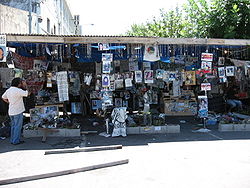- República Cromañón nightclub fire
-
República Cromañón (Spanish for "Cro-Magnon Republic") was a nightclub in Buenos Aires, Argentina.
On 30 December 2004, a fire broke out in the club, killing 194 people and injuring 714[citation needed] others. The venue was playing host to rock group Callejeros and around 3,000 people were in attendance. The blaze was started when a pyrotechnic flare (a popular device in New Year's Eve celebrations) was set off and ignited foam in the ceiling. The materials used in the building for decoration were flammable: mostly wood, styrofoam, acoustic panels and a plastic net (a so-called media sombra). This plastic net was hung from the ceiling and caught fire first, melting into a rain of fire. In some parts of the building, teddy bear stuffing was used as a cheap alternative to wool fiber. The owner and the band's lead singer had told the patrons not to use flares inside the building.
Four of the six doors, some of which were fire exits, were chained shut so that "people would not enter without paying", according to Mayor Aníbal Ibarra. Most of the victims died from inhaling poisonous gases, smoke and carbon monoxide, unlike most accidents of this kind, where most die from crushing or burning.
Following the disaster, an Argentine judge issued a national and international arrest order against Omar Chabán, local businessman and owner of República Cromañón and other nightclubs, including one called Cemento that had been closed by court orders many times before. Chabán was located at one of his houses in the neighbourhood of Montserrat and was arrested. Police are now seeking those responsible for setting off the flare. If they are found (some reports say they have already been identified and that they are children), then they could face eight to twenty years in prison.
President Néstor Kirchner decreed three days of national mourning, and city authorities forbade concerts and closed all nightclubs in Buenos Aires during the mourning period.
Investigation results
It later became known that República Cromañón was overdue for a fire hazard inspection since late November 2004. Although Mayor Ibarra blamed the Fire Department of the Argentine Federal Police (responsible for the inspections), several flaws in the city's inspection system surfaced. Coupled with the city's poor capability to handle a disaster of this magnitude, critics pointed to Ibarra for failing to reorganize Buenos Aires' inspection system. A few days after the fire, Ibarra reshuffled the entire Buenos Aires security and emergency administration. The City Legislature announced that Mayor Ibarra was going to face a questioning session. However, the Legislature failed to achieve the necessary votes to question Ibarra. Shortly after, Ibarra voluntarily submitted to a questioning session, and announced a recall referendum to decide whether he would remain in office or not.
Relatives and friends of the dead organized several marches to Plaza de Mayo demanding the resignation of Aníbal Ibarra as Mayor of Buenos Aires, the conviction of Omar Chabán and more efficiency in the inspection system. Some of these marches ended with incidents between protesters and the police.
President Kirchner also suffered heavy criticism for his actions (or lack thereof), especially for staying at his holiday retreat of El Calafate, Santa Cruz, instead of returning to Buenos Aires, and for remaining silent for five days. Kirchner responded in an aggressive manner, blaming the criticism on the yellow journalism and on journalists "full of hatred", explaining his decision not to return to Buenos Aires as trying to avoid sensationalism. Critics of the President have contrasted Kirchner's actions during the Cromañón tragedy with his actions during the collapse of a mine shaft in his home province of Santa Cruz, when he quickly went to the site.
On 14 November 2005, an impeachment jury formed by a commission of the Buenos Aires Legislature suspended Mayor Ibarra for four months, pending investigation of his performance that could lead to his destitution. He has accused the opposition of manipulating the families of República Cromañón's victims in order to ruin his career. On 7 March 2006, after four months of deliberations, the impeachment jury voted to remove Ibarra from office.
A trial started on 19 August 2008 and finished 1 year later. The defendants were sentenced as follows:
- Omar Chabán: 20-year prison sentence
- Raúl Villarreal: 1-year suspended prison sentence
- Callejeros: Acquitted, then retried in 2011: 11-year prison sentence[1]
- Diego Argañaraz (manager of Callejeros): 18-year prison sentence
- Fabiana Fiszbin (ex Control secretary): 2-year prison sentence
- Ana María Fernández (ex Buenos Aires government servant): 2-year prison sentence
- Subcommissioner Carlos Díaz: 18-year prison sentence
- Commissioner Miguel Belay: acquitted
References
External links
- Documentary Video explaining several government flaws that led to the tragedy
- Fire at Buenos Aires Nightclub Kills 174" at ABCNEWS.com
- "Scores die in Argentina club fire" at BBC news
- Que No Se Repita: Main organization that groups victim and survivor families and is undertaking legal actions.
- The official list of death in the tragedy
- Los pibes de Cromañón Memoria y Justicia por Nuestros Pibes - Grupo de Familiares, amigos y sobrevivientes de Cromañón.
Coordinates: 34°36′33″S 58°24′35″W / 34.60917°S 58.40972°W
Mass casualty club fires Pre 1940 Study Club fire1940–1969 1970–1979 Club Cinq-Sept fire · Blue Bird Café fire · Whiskey Au Go Go fire · UpStairs Lounge arson attack · Summerland disaster · Beverly Hills Supper Club fire1980–1999 Stardust fire · Alcalá 20 nightclub fire · Happy Land fire · Kheyvis · Ozone Disco Club fire · Gothenburg discothèque fire2000–2004 2005–2009 Categories:- Nightclub fires
- Fires in Argentina
- 2004 in Argentina
- History of Buenos Aires
- Fire disasters involving barricaded escape routes
- 2004 fires
- Presidency of Néstor Kirchner
Wikimedia Foundation. 2010.


